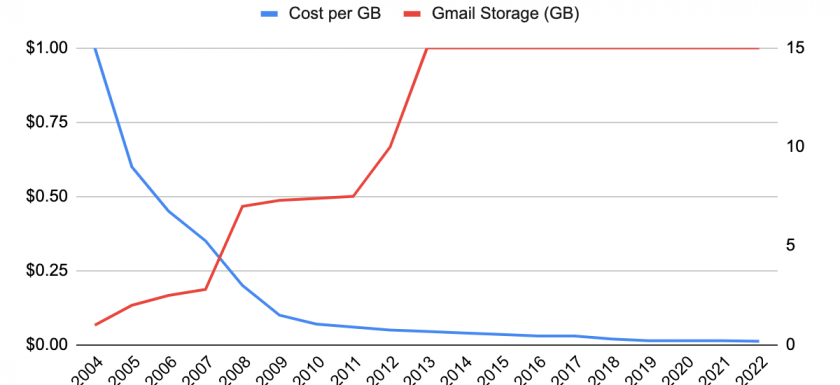
Did you know that Yahoo Mail currently offers 1TB of storage capacity? That’s 66 times the capacity Gmail offers today (15 GB), which hasn’t increased since 2013.
I didn’t either, until I checked for this article. After all, who uses Yahoo anymore, thanks to Gmail’s market dominance? But it’s that time of year again, when Google tells me I’m almost out of space, and prompts me to pay a monthly subscription fee for Google One. Gmail, the free product that encouraged users to archive instead of trash and “never throw an email away”, and pioneered an ever increasing amount of storage… until they didn’t, and monetized.
In light of this, I wanted to take a look back and chart both the history of Gmail and storage prices, and discuss if they’re where they should be or if they’re lagging behind.
Gmail Storage
Gmail came on the market in 2004 in a limited “beta” release, and was invitation only for a while. I got an invite from my friend Chris, who was very tech-forward and raved about it. Gmail offered 1GB of storage, 10x more than its closest competitor at the time (Yahoo at 100MB), and told users they could archive and keep all their email history. In 2005, Yahoo bumped their storage up to 1GB to match Gmail, who promptly doubled theirs to 2GB.
Gmail then started constantly adding capacity to compensate for incoming emails, and a little counter of increasing space was ever present. It was a neat gimmick. By September 2006, capacity had slowly grown to around 2.7GB, but was tapering off. It didn’t hit 2.8GB until a year later in September 2007.
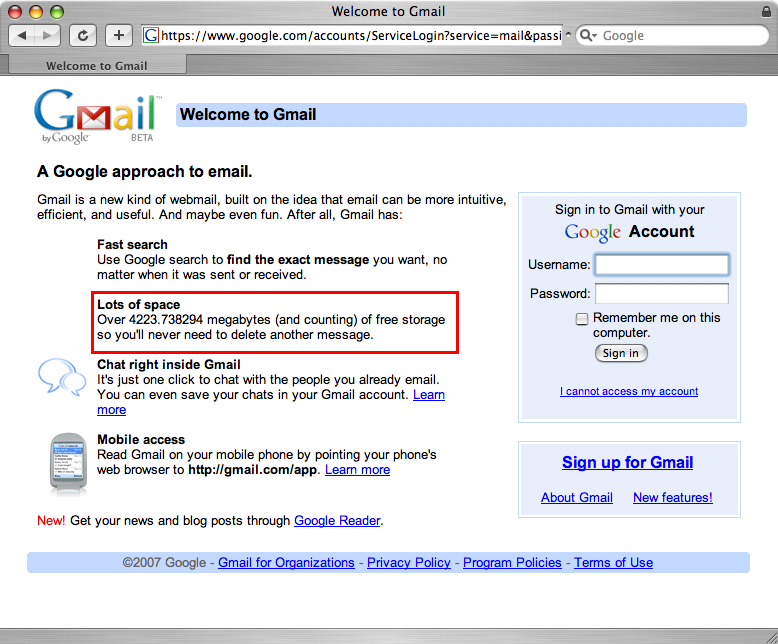
In Fall 2007, Gmail had its largest increase yet. Storage jumped from 3 to 6 GB by January 2008, and tapered off above 7GB by the end of 2008. (Source here.)
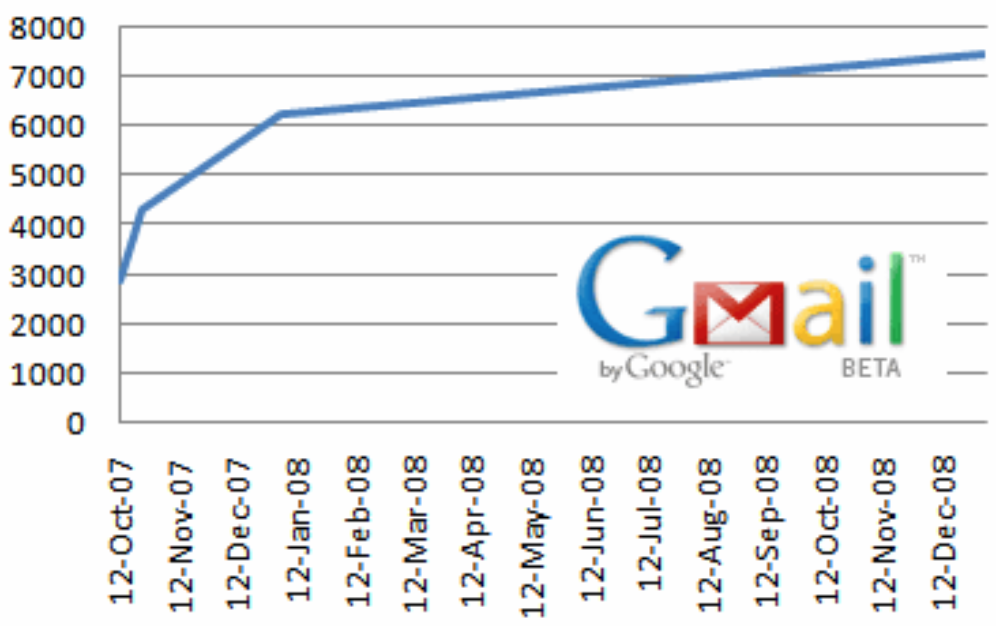
Up to this point, and even into 2010, I think it’s reasonable to say that Gmail capacity seemed huge. The product was limited to emails, and attachment size was limited to less than 25MB, so it would have been very difficult to exceed the allotted space, even for power users.
However, some things changed in the next few years:
- Storage advanced quickly, becoming much larger and less expensive
- Google Drive was introduced in April 2012, allowing general file storage in addition to just email, and began charging for additional storage over the free limit
- In 2013, Gmail storage (now Google, as it includes Drive) was increased for the last time to 15GB and hasn’t been increased in almost a decade.
Storage Cost per Gigabyte
Meanwhile, while Google kept their free storage capped at 15GB, storage capacities and speeds exploded and prices plummeted. Today, some of the fastest 1TB solid state drives are under $75, and external 4-8TB drives are under $100.
It can be difficult to estimate storage prices, especially at cloud/enterprise levels, but this article from Backblaze was very helpful up to 2017, and digging through several other sources and spot checks of existing pricing gives an educated estimate. 2011 saw a big spike in prices due to flooding at factories in Thailand, but pricing recovered thereafter and averaged out, which is why it’s not reflected.
The following chart consolidates Gmail’s storage history and enterprise storage pricing history per gigabyte, from Gmail’s inception in 2004 to the present day.
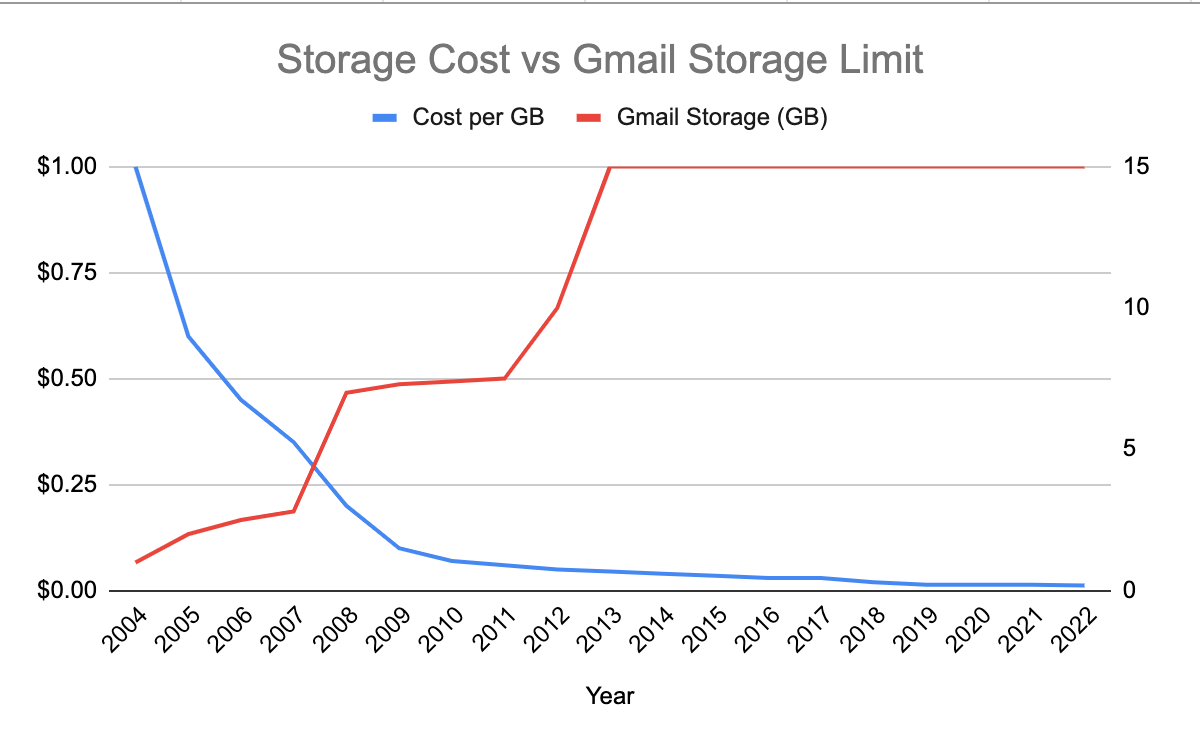
Analysis
The questions that arise from this data are “What is the value of Gmail?”, and, “Has it kept pace with technology advances? If not, what should it be?”.
Using the information above, the next chart plots the value of Gmail’s storage offering over its entire history.
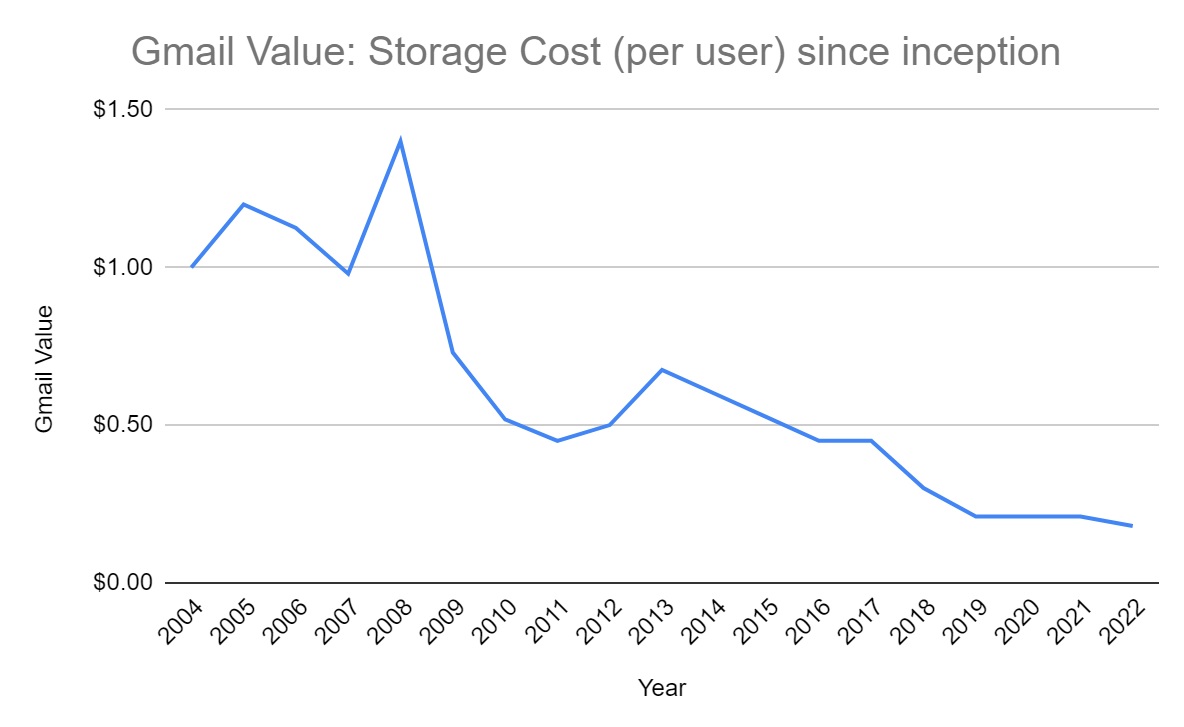
We can now use all of this data to take a look at our questions.
The value of Gmail’s storage, when it launched in 2004, was just about one U.S. dollar. It peaked in 2008, when it was around $1.40, and is now at its lowest point, at just $0.18 per user.
Has it kept pace with technology advances? That answer is clearly No, given how far storage has advanced in the last decade. Strictly from the data, storage costs in 2013 were around $0.045/GB, and today are around $0.012/GB, about 4x cheaper.
A much trickier question to answer is, what should the free limit be today? A market-driven answer is clearly: whatever encourages the most users to pay for Google One! However, given how inexpensive storage is now, the spirit of the original project (never delete an email!), and the profit Google derives mining advertising profiles from email content, the free product can be more competitive.
Using our data and some market interpretation, I think we can arrive at a better answer:
- Introductory pricing is always generous, to entice users to switch to a completely new platform. I think it’s fair, therefore, to consider the original cost of Gmail per user, $1 (83.3 GB today), as the extreme “upper limit” of value for a free offering. It’s possible they even lost money in the early days of adoption.
- Storage costs have gotten four times lower in the last decade, and (admittedly distant) competitors are offering much more storage in their products. I therefore consider 4x current levels a fair lower limit of value, essentially matching what was offered in 2013. That would be 60GB (15 x 4), or a cost of $0.72 per user.
- This gives a range of 60-83GB, or $0.72-1.00, per user.
- Obviously Google wants some margin between their free and paid products. Google One’s current ‘Basic’ tier starts at 100GB, I would argue that’s too low for a paid product today (just $1.20 of value for something that costs $1.99/month, with redundancy and cloud access of course).
Given this, I propose:
- A fair market value for Gmail’s storage limit in 2022 is $0.60 per account, or 50GB.
- Google One should increase their Basic tier to 200GB and Standard to 500GB, Premium remains 2TB. This provides enough spread between the free and paid options, and gives a sufficient level of value to paying customers.
Conclusion
What do you think? Am I spot on, low, or high, in your opinion?
I started looking at all this data out of curiosity and, frankly, incredulity that Google hasn’t increased their storage limit in almost ten years. My initial gut feeling was Google should offer way more than they do, say 1TB like others. After crunching all the data I actually convinced myself that they’d be pricing themselves out of the market if they did so, and that a lower limit is justified, but about 3.5 times higher than what it is now. A 50GB limit would alleviate much of the pressure on average users without cannibalizing the power and business user markets, who need and will pay for Google One.
I hope you enjoyed this article. Collecting all of the data to consolidate into the charts was actually quite difficult, as some of it is hard to come by or is spread out across old blog posts and such. Sources are cited below that helped collect all of this into one cohesive picture.
Sources:
Gmail capacity over time: Source 1, Source 2, Source 3, Source 4
Storage prices over time: Source 1, Source 2, Source 3, Source 4